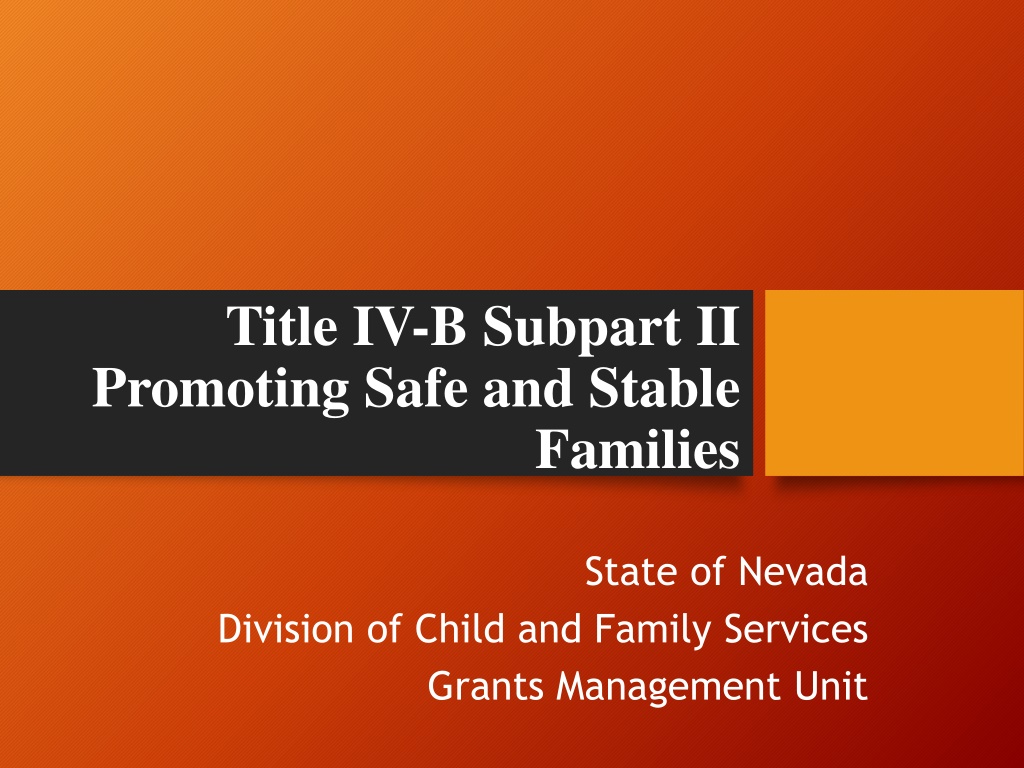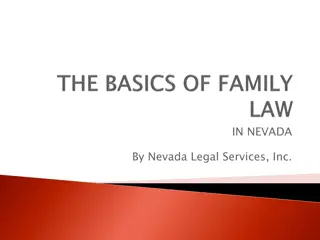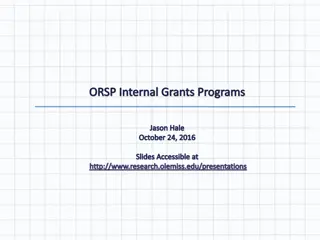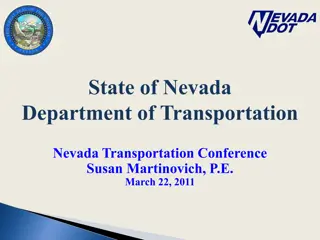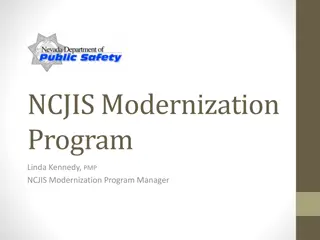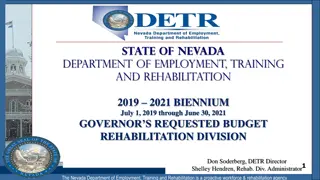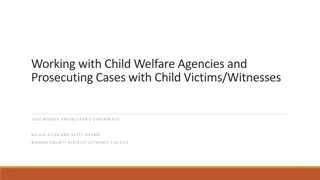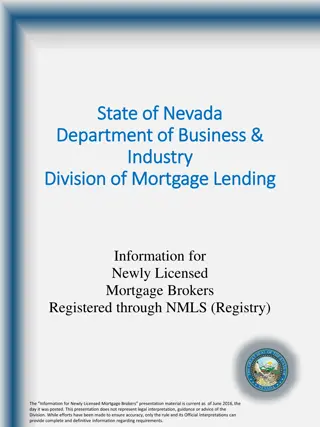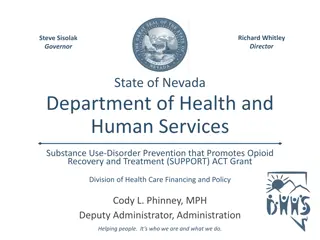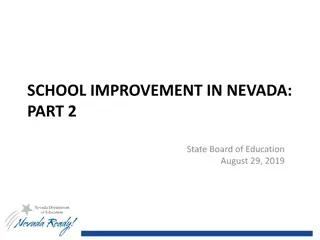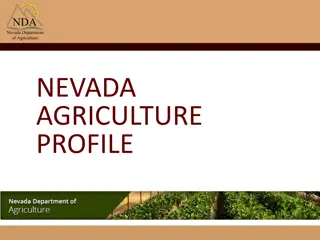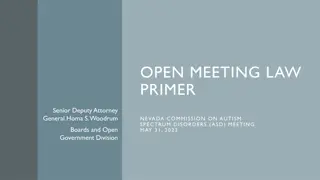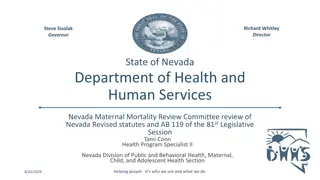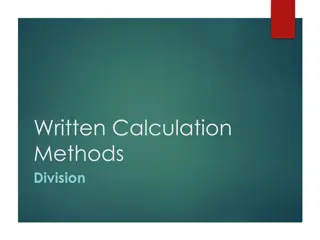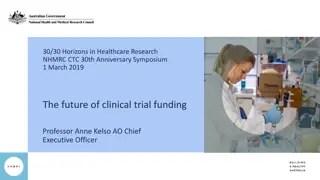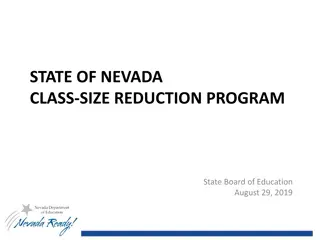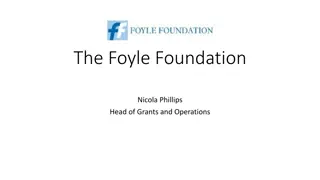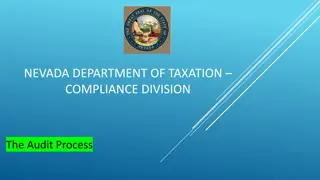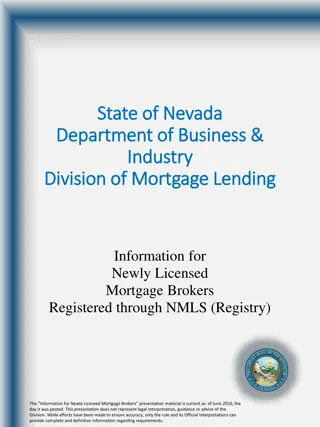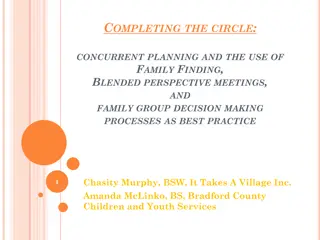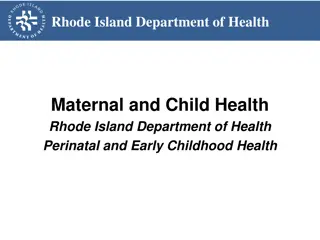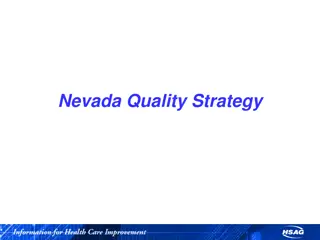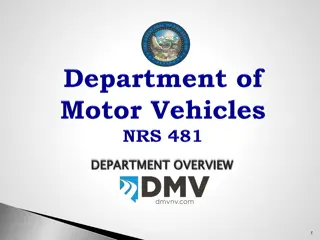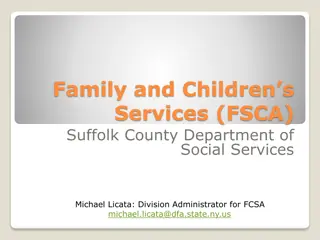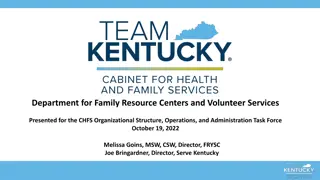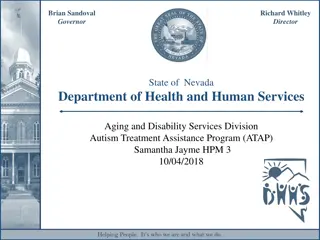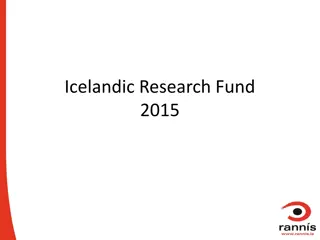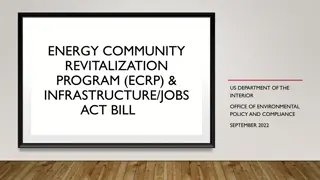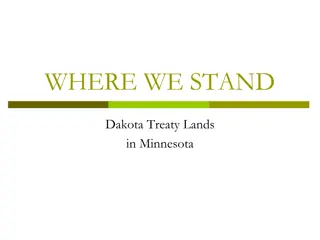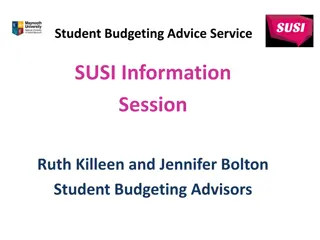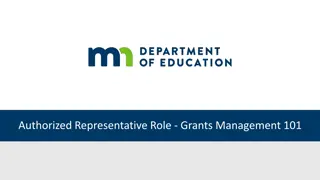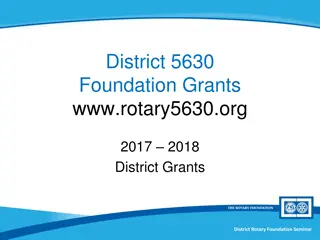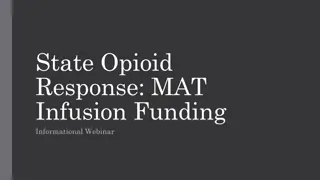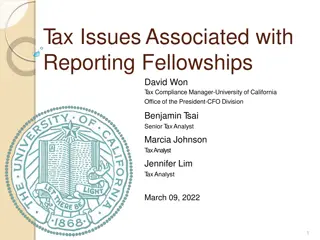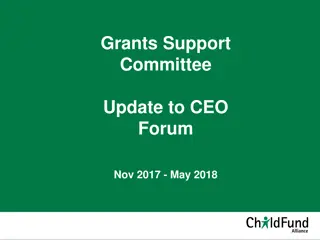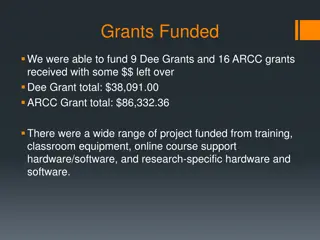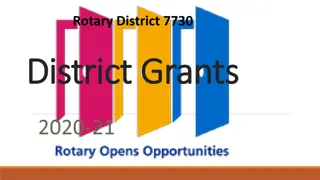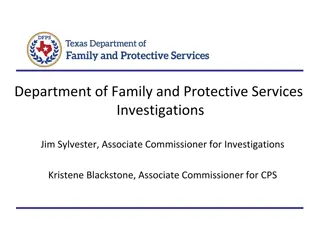Nevada Division of Child and Family Services Grants
This information pertains to grants under Title IV-B Subpart II for promoting safe and stable families in Nevada. Eligibility criteria, funding details, service priorities, proposal deadlines, and geographical funding allocation are highlighted. Community-based organizations, school districts, tribal governments, and local government agencies are eligible for funding to provide designated services in specific regions. Important dates and service priorities are outlined for interested applicants.
Uploaded on Oct 08, 2024 | 0 Views
Download Presentation

Please find below an Image/Link to download the presentation.
The content on the website is provided AS IS for your information and personal use only. It may not be sold, licensed, or shared on other websites without obtaining consent from the author. Download presentation by click this link. If you encounter any issues during the download, it is possible that the publisher has removed the file from their server.
E N D
Presentation Transcript
Title IV-B Subpart II Promoting Safe and Stable Families State of Nevada Division of Child and Family Services Grants Management Unit
Welcome to the Title IVB-2 Pre- Application Workshop 2 Welcome and Introductions Project Principal, Aaron McVean (ODES) Grants Manager, Dorothy Edwards Grants and Projects Analyst II, James Thorne (IVB-2) We will start with a brief overview of the IVB-2 RFP and finish with a question and answer session. Questions may be submitted through the Chat Function during the presentation, however we ask that you please refrain from asking questions over the phone until the end of the presentation. Please mute your phones during the presentation portion to minimize interference, thank you.
Who is Eligible to Receive Funding? 3 Community based organizations School districts Tribal governments Local government agencies
Please Be Informed 4 Proposal Deadline: Proposals must be received by Friday, April 22, 2016 5:00pm Funding Period: July 1, 2016 through June 30, 2019 with annual budgets from July 1 through June 30. Please Note: Awards will be evaluated annually with special emphasis given to regional service array needs.
How Much Funding is Available? The approximate percentage of funds will be allocated to the following geographical areas: 5 Clark County: 70% Washoe County: 20% Rural Region (all rural counties): 10% Preference will be given to applicants who propose services identified as a priority.
Service Priorities: Preference will be given to applicants providing the services in the specified regions (Priorities to be provided by local child welfare representative) 6 Rural Region Washoe County Crisis stabilization and support services Prioritized intake appointments for WCDSS clients Substance abuse, mental health, and parenting services Safety services Facilitators to conduct safety team meetings within 72 hours of removal or to prevent removal from child's home Home Studies/Social summaries Clark County Medical Wraparound services Community based services to promote safety and well being Facilitators to conduct safety team meetings Prioritized intake appointments weekly for DFS clients Home Studies and Home Study updates In-home and/or community based: Family Stabilization and support Services Outpatient mental health screenings/counseling Safety management services Substance abuse screenings/counseling Court approved classes Training to community stake holders in evidence based or empirically supported interventions for children and families See Pages 8-9 of the RFP for more details. See Pages 5-7 of the RFP for more details. See Pages 7-8 of the RFP for more details.
Family Support 7 In-home and/or community based services to promote the safety and well-being of children and families designed to increase the strength and stability of families (including adoptive, foster and extended families), to increase parents confidence and competence in their parenting abilities. Services could include: Developmental Screenings Mentoring Tutoring Health education for youth Parenting Classes Group or individual counseling Home visits
Family Preservation 8 Family Preservation are pre-placement services for children and families at risk or in crisis. Service may include: Intensive family preservation Post-adoptive support services Counseling Day care Homemaker services Services to increase parenting skills Coping with stress, health and nutrition Respite care
Family Preservation (continued) 9 Reunification Services: Services to help children, where appropriate, return to families from which they have been removed or be placed for adoption or legal guardianship These services may include: Short term emergency day care services Homemaker or caretaker services Family or individual counseling for parent(s) and child Follow-up care to families to whom a child has been returned after placement and other reunification services the State identifies as necessary
Time-Limited Family Reunification 10 Services and activities that are provided to a child that is removed from the child s home and placed in a foster family home or a child care institution and to the parent or primary caregiver of such a child, in order to facilitate the reunification of the child safely and appropriately within a timely fashion but only during the 15-month period that begins on the date that the child is considered to have entered foster care. These services may include: Individual, group and family counseling Inpatient residential or outpatient substance abuse treatment services Mental health services Assistance to address domestic violence Temporary emergency child care and therapeutic services Transportation to or from any of these services
11 Adoption Promotion and Support Services Services and activities designed to encourage more adoptions out of the foster care system, when adoptions promote the best interests of children, including pre- and post-adoptive services and activities designed to expedite the adoption process and support adoptive families. These services may include: Recruitment and preparation of adoptive families interested in the placement of children awaiting adoption Completion of adoption home-study assessments or social summaries of children waiting to be adopted Post placement supervision of children in adoptive placement Counseling, treatment, intervention, support group activities for adoptive families of special-needs children Respite care services to adopted special-needs children
12 Grant Application Process and Instructions All materials must be submitted on white paper, typed, single-spaced, Times New Roman, size 12, black font and kept within specified page limits. The name of the applicant agency and page number must be clearly indicated by footer on each page. Narrative submissions must address each of the following areas: Title IV-B, Subpart II priority service areas Goals and Objectives Methods and Services Performance Measures and Program Evaluation Annual Budget Detail and Budget Narrative One (1) original hard copy and one (1) electronic copy in PDF format included on CD or Flash drive. (graphics and logos must be removed)
Organizational Summary 13 Provide a summary of your agency. Description of organization structure, the mission, history and total budget for the agency. Explain experience the organization has providing services proposed. List of program services currently offered & frequency. Description of agency key staff and qualifications.
Proposal Narrative, Sequence and Scoring Proposed services to be funded(4 page max) Describe the target geographical areas and location. Agencies proposing in-home services should describe the communities and/or counties services will be provided. Description of challenges faced by the target population & specify needs. Describe service category Family Support Family Preservation Time-Limited Reunification Adoption Promotion/Support (Each of the four service categories must be evaluated separately) 14
Proposed Services to be Funded (continued) 15 Detailed discussion of the service being proposed Program implementation timeline that shows when each program component will be initiated. Best practices or evidence-based service models. Proposed method of service delivery. Describe how services will be provided to individuals with disabilities.
Proposed Services to be Funded (continued) 16 Description of children/families to be served during one year. How services will be staffed & qualifications Indicate position responsible for data Executive Directors/Program manager on-line program report approval required Training for staff of proposed services. Communication and collaboration with local child welfare agencies. Statement of agreement to participate in the on- site review process.
Evaluation & Outcomes (4 page max) 17 Programs previously funded by Title IV-B Subpart II, are required to provide an analysis of year to year outcomes achieved for children & families. Programs not currently receiving Title IV-B Subpart II, should document the agency s capacity to track and report data.
Budget Forms Detailed Budget (Year 1) 18 Name Annual Salary Percent of FTE Grant Salary Requested Fringe Benefits 25% Match or in-kind Total Funds Requested John Doe $40,000 10% $4,000 $2,000 $2,000 $6,000 (Calculates) SUBTOTAL $ $ Grant Funds Requested 25% Match or in-kind Total Program Contractual $Calculates Equipment Operating Travel Other TOTAL MATCH $Calculates Total Requested for Year 1 $Calculates (Each of the four service categories must include a separate budget)
19 How Do I Calculate Match? The Federal equation for match is: Dollar amount requested .75 = Program Cost Program Cost x .25 = Match Example: $100,000 requested .75 = $133,333.33 (Program Cost) $133,333.33 (Program Cost) x .25 = $33,333.33 (Match) -The required Match amounts may exceed the Federal formula in order to provide the Match necessary to administer the grant by DCFS. -In order to be considered for Title IV-B, Subpart II funding the agency must be able to meet the required Match.
Budget Definitions 20 Personnel: Positions to be funded, salaries, fringe (based on % of time person will work on the individual project) Contractual Services: - Independent contractors and consultants - Describe each contractor s Scope of Work, rate, hours and cost Equipment: - Equipment costing $5,000 or more - Each item must be itemized and listed separately - All equipment must be marked as IVB-2 property
Budget Definitions (continued) 21 Operating: Agency s rent, utilities, basic maintenance, repairs, telephone, fax, postage costs, supplies, insurance coverage, dues, conference fees, subscriptions, program costs, equipment which cost less than $5,000 Travel: Detail cost of travel. Travel costs cannot exceed GSA federal rates. Other: - Other allowable costs not covered in previous categories - Federal law prohibits the provision of food, liquor, or employee moral as a reimbursable item.
Budget Definitions (continued) 22 Indirect Costs: - Are costs that have been incurred for common or joint purposes and benefit more than one cost objective that is not easily assigned to a specific award. - Applicants may request an Indirect Cost Rate of up to 10% with DCFS by including an indirect cost rate proposal and related documentation which must be provided with the RFP to be considered. -Indirect Cost Rate Proposals exceeding 10% must submit their proposal to the Federal awarding agency. -Federal Indirect Cost Rate Proposal instructions can be found in 2 CFR Part 225, Appendix E.
Budget Definitions (continued) 23 Indirect Costs (continued): - If the applicant already has a federally approved Indirect Cost Rate they must provide their Certificate of Indirect Cost Rate. - To be eligible for reimbursement of indirect costs, indirect rates must be included in the RFP application and the rate may not be renegotiated during the grant award period. -Sub grantees must calculate and request indirect costs based on the direct expenses listed in each Request for Funds. Quarterly or annual requests for indirect costs are not allowed.
Program Revenues Example 24 All revenue for the agency/organization must be listed on this form. Funding Source Pending or Secured Time Period Amount 7/01/11-06/30/13 Title IV-B, Subpart II Pending $80,000 10/01/12-9/30/14 Secured $40,000 Children s Trust Fund 10/01/11-9/30/14 WIC Secured $20,000 01/01/13-12/31/15 March of Dimes Pending $20,000 07/01/11-06/30/14 United Way Secured $15,000 07/01/12-06/30/15 Nevada State Welfare Secured $10,000 07/01/12-06/30/15 Funds for Healthy Nevada Secured $10,000 Total Revenue: ______$195,000_______ Please explain any items listed as pending. Pending means that you have applied for funding from another source but have not yet received a Notice of Grant Award.
Personnel Funding Table 25 Name/Position Funding Agency Annual Salary % of salary from other funding sources Total salary allocated to funding source Match Total Salary John Doe Red Cross $40,000 50% $20,000 $0 $20,000 Jane Doe March of Dimes $40,000 50% $20,000 $0 $20,000
Title IV-B Subpart II Scope of Work AGENCY NAME: _______________________________________ PROJECT NAME:_________________________________________ SERVICE CATEGORY: _______________________________________ TARGET POPULATION:_________________________________________ 26 Goal: Global Problem Statement Objective and Timeframe: Documentation: (How will it be measured?) Projected Services #: Cost: 10 presentations 20 public service announcements EXAMPLE ________ Agency will provide 10 presentations and 20 public service announcements in Northern NV each year Calendar, sign in sheets media records, spreadsheets etc. $0.00 Increase public awareness of domestic violence in Northern NV 1. Personnel: $ 2. Operating: $ 3. Travel: $ 4. Contractual: $ 5. Indirect Cost: $ Indirect Cost Rate: % 6. Other (Admin): $
Outcomes 27 Measurable outcomes will be developed for each agency awarded funding Outcome development is based on the following framework, which focuses on: Inputs all human, financial, and physical resources devoted to the program Outputs the number and type of services provided using those resources Outcomes the effect or impact in the lives of clients as a result of providing those services Outcomes are agency specific, and should serve to demonstrate the effectiveness of the funded activity Outcomes will be developed through collaboration with ODES, Inc. and the local Child Welfare Agency
Outcomes FS Example 28 Output Substance abuse counseling services for 100 families. Parenting classes for 200 parents. Outcome 85% of families will not have a new substantiated case of maltreatment/neglect within 12 months of completing treatment.
Expectations After Funding is Granted 29 Programmatic Reporting: The Title IV-B Subpart II Monthly Program Report must be submitted by the fifteenth of the following month Executive Director/Program Manager approval Financial Reporting: The Monthly Financial Status and Request for Funds Report must also be submitted by the fifteenth of the following month Site Reviews and Monitoring: A minimum of one on-site review will be conducted annually
Vendor Information 30 Potential applicants must: Register with the State of Nevada Secretary of State at: http://www.sos.state.nv.us/ Register with the State of Nevada Controller s Office http://vdb.purchasing.state.nv.us/MainMenu.asp
DUNS and SAM 31 Potential applicants must: Obtain a Dun & Bradstreet (DUNS) Number: http://fedgov.dnb.com/webform/displayHomePage.do Register their DUNS Number with the System for Award Management (SAM) http://www.sam.gov
Technical Assistance 32 For specific grant related questions, please contact: James Thorne at JThorne@dcfs.nv.gov or by phone at 775-684-4426 All questions received and answers provided will be made available online at the DCFS website.
33 Q & A Session
34 Proposals must be received by Friday, April 22, 2016 by 5:00pm Division of Child and Family Services 4126 Technology Way, 3rd Floor Carson City, NV 89706 Attn: James Thorne
